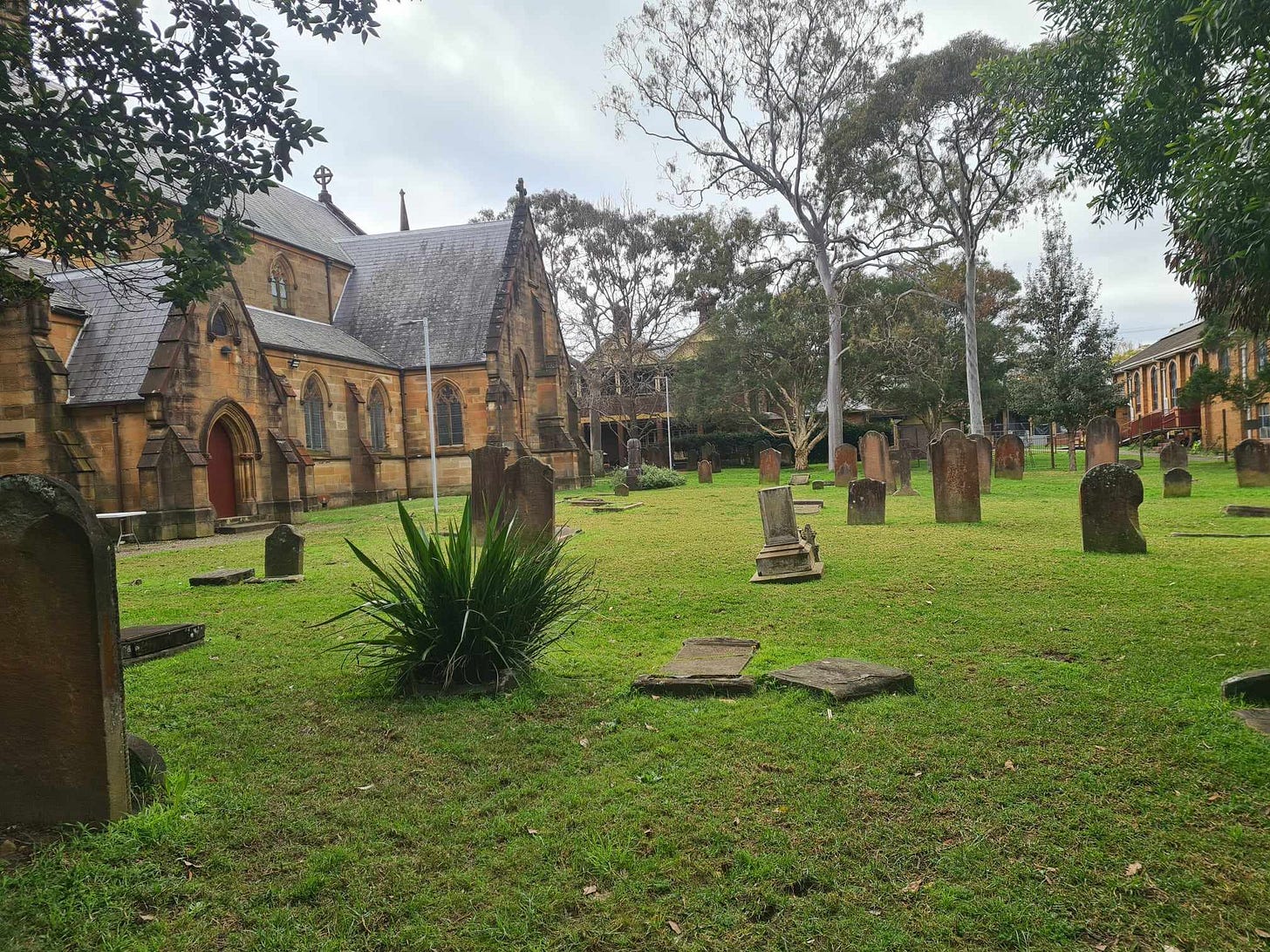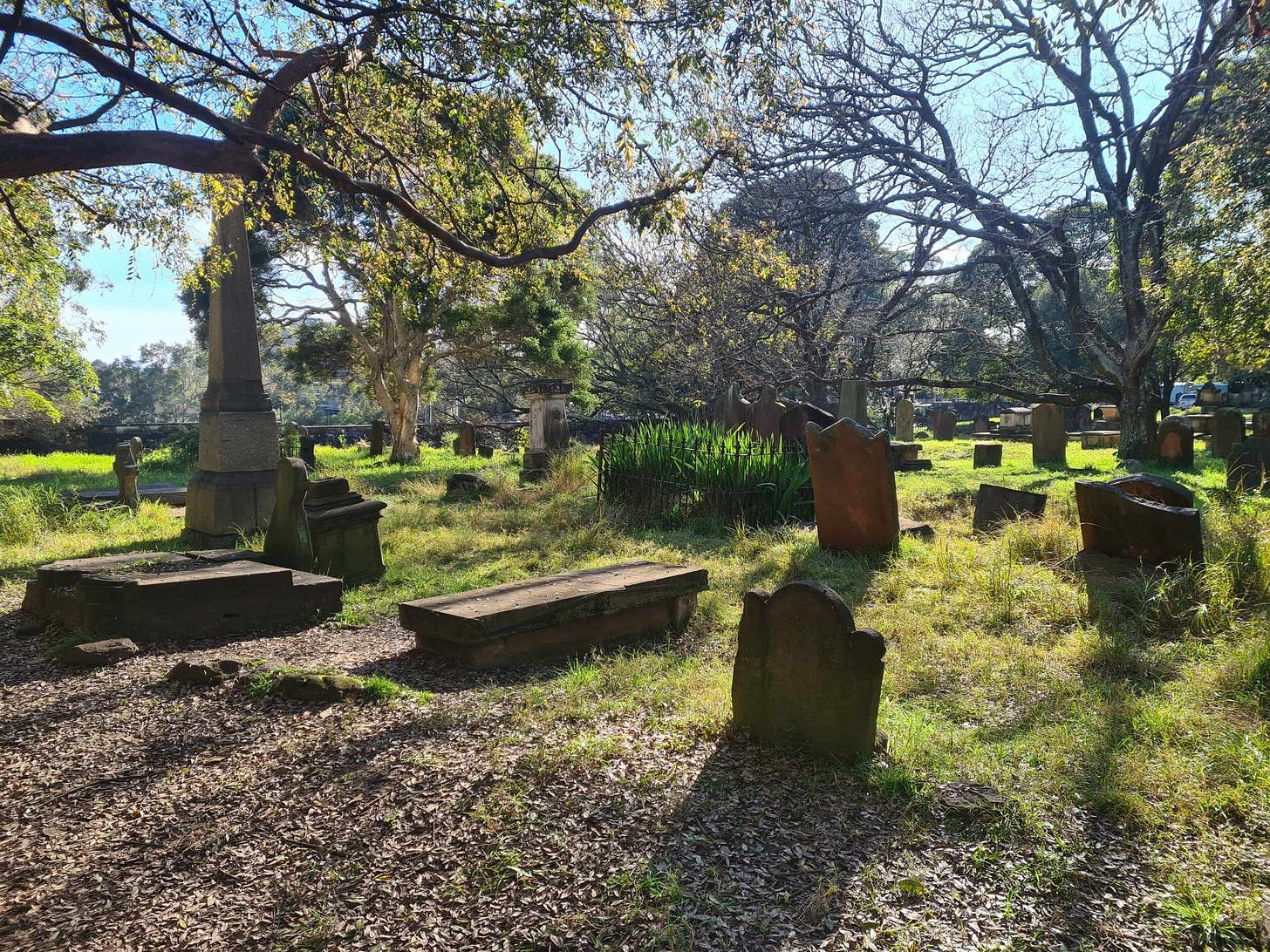I love cemeteries. I’m aware that for most people a visit to a cemetery is not an interesting excursion. I fully anticipate one of my child’s complaints about her childhood will be the number of graveyards (and historic houses, and museums) to which I dragged her. But as I outlined in my piece about embracing the weird, I’ve stopped worrying about what is normal or expected. I am doing what brings colour to my life.
Which takes us to the cemetery.
I’m a big fan of the history of places where we remember the dead and what those places say about how we treat grief. Having a physical location to visit when grieving can a crucial step in the healing process. Having a tangible site to memorialise for my miscarried babies really assisted in my recovery, which I wrote about here.
But today I want to talk about why I appreciate cemeteries, as spaces in our communities, despite all the morbid associations.
Cemeteries help us grieve
This may be an obvious starting place, but in a world where death has increasingly become invisible, I think it is an important one. A cemetery is a physical, tangible reminder that someone died, and people around them noticed and acted in response to that death. That may seem obvious, but I don’t think it’s something we can take for granted.
Cemeteries are a social necessity, to have a place to put our dead to rest, but they are also a deeper marker of how society operates, that we want to gather and mark the passing of those we live with, or work with, or see in the street or at church. We don’t just bury the dead and move on – we construct memorials, we hold services, we leave flowers. Many of these things have gone out of fashion, and I think our grieving process is the worse for it. These rituals highlight the sadness, the permanence of death – but also highlights the ongoing memory of those we have lost, and the continued ways they impact our lives. If you are a Christian, you know that death is not THE end, but it is AN end, and it is right to mourn the sadness of that.
Cemeteries are a time capsule
Camperdown Cemetery sits in the grounds of the church I attend, and occasionally I get to help with tours. This graveyard is a beautiful little time capsule of Australian society in 1848 to 1868.
The cemetery was opened when the population of New South Wales population was expanding, as well as experiencing a series of epidemics. As a result, Camperdown was basically full, or at least bought out, in twenty years. Burials continued but only for those had bought plots or had spaces reserved in family burials. 80% of burials took place in that first twenty years.
To wander through this cemetery and look at the details of the stonework is to see what motifs were popular (the draped urn is everywhere), what names got used and re-used, what causes of death were common, and what people thought was important to dwell on as they recorded and farewelled their loved ones. It’s a rich time capsule into this little slice of 19th century Sydney.
For example – many babies are laid to rest in this cemetery. A high infant mortality rate was a sorrowful reality during these decades in Sydney. But many babies have their cause of death listed as – teething. Obviously, we know today that teething (while extremely unpleasant) can’t be fatal, but as it was often the last noticed symptom, it was assumed to be the cause of death. But in an even more heartbreaking twist, often that last symptom – teething – was treated with a mercury-based medicine – the actual cause of death. Little insights like this can really highlight history and bring it alive, when we consider the lives and tragedies of those who lived so long ago. It can help us understand how far science and medicine have come.
Cemeteries are shared community spaces
I have had many wonderful conversations with strangers in the cemetery. Usually this is because they have come on a tour, but sometimes it’s just happenstance of people being in a shared, interesting place and talking about it. I’ve met lots of people who regularly walk their dog or take their children to the cemetery as a way to get out of their house and connect with the world around them.
Cemeteries, particularly in cities, also provide much needed, well protected green space. Developers are ruthless in their search for land to turn into midrise luxury apartment buildings, but at least so far, they have left the dead and their space alone, for the most part.
(Just a note to say I fully recognise there is a housing crisis, and we need more housing – my complaint is that the housing being built is not affordable, and little consideration is given to what facilities need to be near those new developments for them to be liveable – schools, doctors, shops and green space).
Protected from further development, cemeteries are a place trees and wildlife can thrive, dogs can be walked, children can run free, and nature generally enjoyed. Many former cemeteries are now inner-city parks. There’s something beautifully ironic about places of death now becoming green spaces that literally give oxygen and life from the trees and plants growing there.
Cemeteries can help us think about our life, legacy and eternity
If you need some time and space to reflect, there’s no better place than a cemetery. With walking tracks and interesting inscriptions to read, it’s a great way to detach from your present worries and focus your attention on something else.
But it’s also the perfect place to think about your life and legacy. It’s a stark reminder that no matter what achievements we make, tragedies we endure, good works we produce, we all end up the same – ashes to ashes, dust to dust.
As a Christian, this is a helpful reminder that what I am doing now is not forever. I have an eternal home I am looking forward to, beyond a world with mourning and crying, death and pain. I am looking forward to a day when death no longer has any sting. Spending some time in the graveyard really assists my understanding of just how much it means and how radical it is to look forward to a world without death.
And yet…our life here on earth is not meaningless. Look around and see the names inscribed to live on, monuments erected by loved ones, and plaques that proclaim the empty space in the world where this person once was. Eternity is where we are heading, but what we do on earth matters. The impact we have on those around us matters. At the end of our days, we want Jesus to recognise us as a good and faithful servant – but we also want that to be visible to those around us in this life.
Cemeteries are such wonderful community spaces, time capsules that can help us grieve and reflect on life and the bigger picture. They can also be wonderfully aesthetic, meaningful places, recording the lives and histories of those who have gone before. Rather than seeing them as just a morbid waste of land, we should rejoice that society still honours the dead and makes space for them – and look forward to the day when no cemeteries are needed, for death has been defeated and eternal life is here.






An interesting perspective, much of which I hadn't considered before!
Thanks for writing. :)